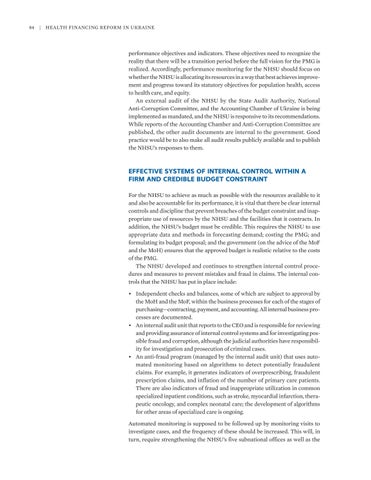84
| Health Financing Reform in Ukraine
performance objectives and indicators. These objectives need to recognize the reality that there will be a transition period before the full vision for the PMG is realized. Accordingly, performance monitoring for the NHSU should focus on whether the NHSU is allocating its resources in a way that best achieves improvement and progress toward its statutory objectives for population health, access to health care, and equity. An external audit of the NHSU by the State Audit Authority, National Anti-Corruption Committee, and the Accounting Chamber of Ukraine is being implemented as mandated, and the NHSU is responsive to its recommendations. While reports of the Accounting Chamber and Anti-Corruption Committee are published, the other audit documents are internal to the government. Good practice would be to also make all audit results publicly available and to publish the NHSU’s responses to them.
EFFECTIVE SYSTEMS OF INTERNAL CONTROL WITHIN A FIRM AND CREDIBLE BUDGET CONSTRAINT For the NHSU to achieve as much as possible with the resources available to it and also be accountable for its performance, it is vital that there be clear internal controls and discipline that prevent breaches of the budget constraint and inappropriate use of resources by the NHSU and the facilities that it contracts. In addition, the NHSU’s budget must be credible. This requires the NHSU to use appropriate data and methods in forecasting demand; costing the PMG; and formulating its budget proposal; and the government (on the advice of the MoF and the MoH) ensures that the approved budget is realistic relative to the costs of the PMG. The NHSU developed and continues to strengthen internal control procedures and measures to prevent mistakes and fraud in claims. The internal controls that the NHSU has put in place include: • Independent checks and balances, some of which are subject to approval by the MoH and the MoF, within the business processes for each of the stages of purchasing—contracting, payment, and accounting. All internal business processes are documented. • An internal audit unit that reports to the CEO and is responsible for reviewing and providing assurance of internal control systems and for investigating possible fraud and corruption, although the judicial authorities have responsibility for investigation and prosecution of criminal cases. • An anti-fraud program (managed by the internal audit unit) that uses automated monitoring based on algorithms to detect potentially fraudulent claims. For example, it generates indicators of overprescribing, fraudulent prescription claims, and inflation of the number of primary care patients. There are also indicators of fraud and inappropriate utilization in common specialized inpatient conditions, such as stroke, myocardial infarction, therapeutic oncology, and complex neonatal care; the development of algorithms for other areas of specialized care is ongoing. Automated monitoring is supposed to be followed up by monitoring visits to investigate cases, and the frequency of these should be increased. This will, in turn, require strengthening the NHSU’s five subnational offices as well as the

